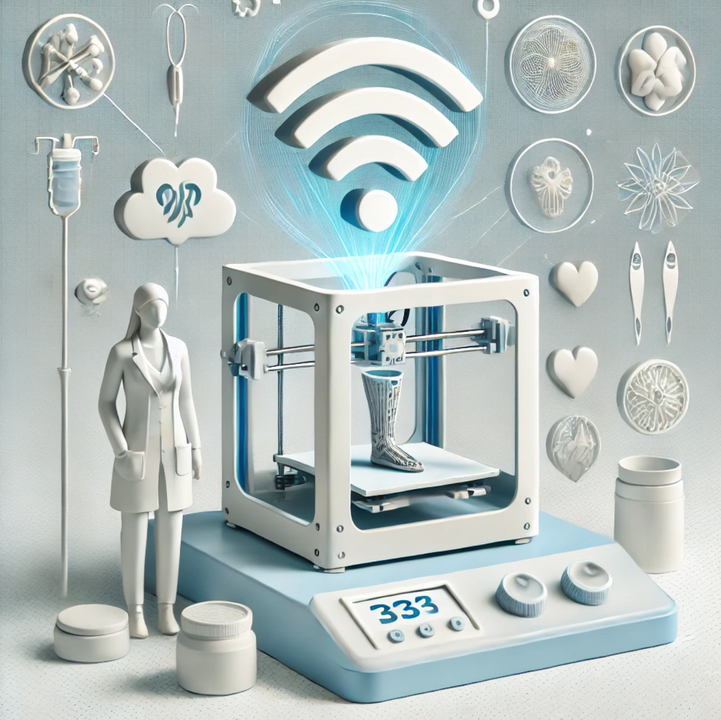The Role of 3D Printing in Revolutionizing Healthcare Equipment
In recent years, 3D printing has emerged as a groundbreaking technology in the medical field, transforming the way healthcare equipment is designed, manufactured, and delivered. With its ability to create custom-made solutions quickly and affordably, 3D printing has revolutionized everything from surgical tools to prosthetics, and even bioprinted tissues. The rise of 3D printing technology is not just a trend—it’s reshaping the future of healthcare.
At Truway Health, we’re excited about the potential of 3D printing to revolutionize healthcare equipment, and we’re leveraging this innovative technology through our proprietary TruPrint Nexus system. Let’s explore how 3D printing is changing the healthcare landscape and what this means for providers and patients alike.
1. Customizable Medical Devices and Implants
One of the biggest advantages of 3D printing in healthcare is its ability to produce customized medical devices and implants. Traditional manufacturing methods often rely on mass production, which can limit customization. However, 3D printing allows for the creation of patient-specific devices tailored to an individual's anatomy.
Examples:
- Prosthetics: 3D printing has made it possible to design prosthetic limbs that perfectly fit the unique measurements of a patient. This not only enhances comfort but also improves functionality and usability.
- Orthopedic Implants: Custom-made implants, such as hip and knee replacements, can be 3D printed to match the exact size and shape needed, improving surgical outcomes and reducing recovery times.
What This Means for You:
With TruPrint Nexus, healthcare providers can offer their patients personalized devices and implants at a fraction of the cost and time required for traditional methods. Customization leads to better patient outcomes and higher satisfaction rates.
2. 3D-Printed Surgical Tools
Surgical tools are another area where 3D printing is making a huge impact. Traditional surgical instruments can be expensive and often require long lead times to produce. With 3D printing, medical professionals can create precision instruments tailored to specific procedures, even for complex surgeries.
Key Benefits:
- Rapid Prototyping: Surgeons can quickly design and print instruments customized to the surgery’s requirements, ensuring precision and improving surgical efficiency.
- Cost Savings: 3D-printed tools can be produced at a lower cost, particularly when only small quantities are needed for specialized procedures.
The Truway Health Advantage:
At Truway Health, we offer healthcare providers the ability to 3D print custom surgical tools through our advanced technology solutions. These tools are not only cost-effective but also enhance precision during complex surgeries.
3. 3D Printing for Prosthetics and Orthotics
For patients who require prosthetics or orthotics, 3D printing provides a level of customization and comfort that was previously unattainable. Unlike traditional prosthetics, which can be heavy, costly, and difficult to adjust, 3D-printed versions can be lightweight, durable, and highly customized to each patient’s body.
How It Works:
- Scanning: 3D printers can use a patient’s specific measurements, obtained through digital scanning, to create perfectly fitted prosthetics or orthotics.
- Customization: Not only do 3D-printed devices fit better, but they can also be customized in appearance to match the user’s preferences, making them more personal and aesthetically pleasing.
TruPrint Nexus at Work:
Using our TruPrint Nexus technology, we’re offering customizable and affordable prosthetics and orthotics that enhance patient mobility and comfort, providing life-changing solutions for individuals with mobility challenges.
4. Bioprinting: The Future of Tissue Engineering
Perhaps the most exciting development in 3D printing is bioprinting—the ability to print living tissues and organs. While still in the early stages, bioprinting holds the promise of creating tissues for organ transplants, skin grafts, and wound healing.
Future Applications:
- Organ Transplants: In the future, 3D printing could eliminate the need for organ donors by allowing doctors to bioprint organs using a patient’s own cells, significantly reducing the risk of rejection.
- Wound Healing: Bioprinted skin grafts could revolutionize the treatment of severe burns and other injuries, accelerating the healing process and improving outcomes.
What to Expect:
While bioprinting is still under development, Truway Health is keeping a close eye on these advancements. We’re committed to staying ahead of the curve and introducing cutting-edge solutions as this technology becomes commercially available.
5. Faster Prototyping and Production of Medical Equipment
Traditional methods of producing medical equipment can be time-consuming and expensive. 3D printing dramatically reduces lead times, allowing manufacturers and healthcare providers to prototype and produce medical devices much faster. This is particularly important during emergencies, pandemics, or when specialized equipment is in short supply.
Key Benefits:
- Rapid Prototyping: Medical innovators can quickly develop and test new equipment designs, leading to faster innovation cycles.
- On-Demand Production: Healthcare facilities can produce essential medical devices on demand, reducing the need for large inventories and lowering costs.
Truway Health’s 3D Printing Solutions:
With TruPrint Nexus, our clients benefit from the ability to rapidly prototype and produce customized medical devices. Whether it’s a surgical tool or a complex prosthetic, our solutions ensure fast turnaround times and high-quality results.
6. Cost Efficiency in Healthcare
One of the major benefits of 3D printing in healthcare is its potential to lower costs. By reducing the need for mass production, shipping, and storage, 3D printing allows for on-demand production at a lower cost. Additionally, the ability to create highly personalized medical equipment reduces waste and improves the efficiency of healthcare delivery.
Financial Benefits:
- Lower Production Costs: 3D printing eliminates many of the costs associated with traditional manufacturing methods.
- Reduced Waste: Only the necessary materials are used in the printing process, minimizing waste and reducing the environmental impact.
Truway Health’s Commitment to Affordability:
At Truway Health, we’re focused on making healthcare more accessible by offering affordable 3D printing solutions for medical equipment. By cutting down production costs, we can pass those savings on to our customers without compromising on quality.
Conclusion: 3D Printing is Shaping the Future of Healthcare
The impact of 3D printing on healthcare is already profound, and as the technology continues to advance, its role in the industry will only grow. From customized implants and surgical tools to groundbreaking bioprinting techniques, the future of healthcare is more personalized, efficient, and innovative than ever before.
At Truway Health, we’re proud to be at the forefront of these changes, offering state-of-the-art 3D printing solutions through our TruPrint Nexus technology. Whether you're a healthcare provider looking to improve patient outcomes or a facility aiming to streamline operations, our 3D printing services provide the customized, cost-effective solutions you need.
Contact us today to learn how Truway Health can help you revolutionize your healthcare equipment with the power of 3D printing.
Truway Health News & Insights
Truway Health Launches Innovative In-Vitro Cryo-Therapeutic Clinical Study
Advancing Cellular Preservation, Precision Therapy, and Translational Science Truway Health, Inc. is...
Everyday Stress, Handled: Practical Ways to Feel More Steady Day to Day
Everyday Stress, Handled: Practical Ways to Feel More Steady Day to Day Everyday stress is the mind-...
Creating Your Personalized Health Roadmap: Break Bad Habits and Build Long-Term Well-Being
Creating Your Personalized Health Roadmap: Break Bad Habits and Build Long-Term Well-Being Improving...
Breathe, Refuel, Recharge: Finding Your Daily Balance
Written by Perry JohanssenPublished and Edited by Truway Health Life rarely slows down on its own. B...
Truway Health Launches “ImmuneNet”: A New Era in Quantum-Synaptic Immunotherapy
Reimagining How Immunity Can Be Understood and Guided At Truway Health, innovation never sleeps.Toda...
Announcing the HEALTH Trial: Humanoid Evaluation and Learning in Healthcare
Published by Truway Health, Inc.Principal Investigator: Gavin SolomonClinicalTrials.gov Identifier:...







